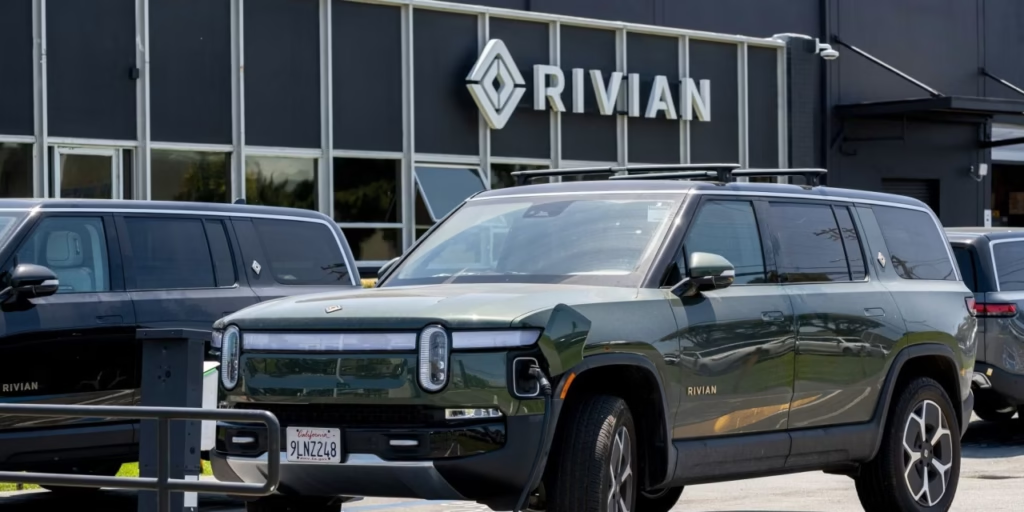The electric vehicle (EV) industry has been facing a rough patch lately, and two of the most prominent startups — Rivian and Lucid Motors — are showing signs of strain. In recent developments, Rivian’s financial results have taken a hit due to the scrapped EV tax credit, while Lucid has revised its production forecast downward amid slowing demand and persistent supply challenges.
These changes reveal a larger story unfolding in the EV sector — one where rising costs, changing regulations, and shifting consumer expectations are pressuring even the most promising players.
Let’s dive into what happened, why it matters, and what the future could look like for these two high-profile electric car manufacturers.
Understanding the Rivian EV Tax Credit Impact
Rivian Automotive Inc. reported that its latest quarterly results were negatively impacted by the removal of a key EV tax credit, which had previously helped to lower the cost of its vehicles for many U.S. buyers.
What Was the EV Tax Credit?
For years, the U.S. government provided a $7,500 tax credit for consumers buying new electric vehicles. However, to qualify, EVs had to be assembled in North America, and their batteries needed to meet certain local sourcing requirements.
Rivian’s R1T pickup and R1S SUV previously qualified for this incentive. But regulatory changes, particularly new rules under the Inflation Reduction Act (IRA), removed many vehicles from eligibility — including some Rivian models.
How Did This Affect Rivian?
The scrapped credit means buyers must now pay thousands more out-of-pocket, which reduced demand, especially among cost-sensitive consumers. As a result:
- Rivian’s net losses increased in the latest quarter
- The company revised down its gross margin expectations
- Investors reacted with caution, leading to a drop in share price
In short, the Rivian EV tax credit impact wasn’t just about consumer incentives — it directly affected the company’s bottom line and growth strategy.
Lucid Cuts Production Forecast: A Different Kind of Pain
While Rivian deals with tax-related fallout, Lucid Motors is battling its own challenges. The company, best known for its luxury Lucid Air sedans, announced that it would slash its production forecast for the remainder of the year.
Why Is Lucid Cutting Production?
Lucid originally planned to manufacture around 9,000 vehicles this year. But due to:
- Softening demand for high-end EVs
- High manufacturing costs
- Ongoing supply chain issues
The company now expects to produce only around 6,000–7,000 units.
Lucid CEO Peter Rawlinson noted that the company is taking a “disciplined approach to growth,” and would rather cut costs and match production to demand than flood the market with unsold inventory.
Financial Performance Highlights:
- Revenue for the quarter came in lower than analysts’ estimates
- Operating losses remained high
- Lucid reported a significant cash burn, though it still has over $4 billion in liquidity
The company insists it remains focused on the long-term EV luxury market, but the short-term outlook appears more cautious.
What the Numbers Say
Here’s a quick breakdown of how both companies are performing financially:
| Metric | Rivian (Q2 2025) | Lucid Motors (Q2 2025) |
|---|---|---|
| Revenue | $1.2 Billion (approx.) | $150 Million (approx.) |
| Net Loss | $1.4 Billion | $764 Million |
| Vehicle Deliveries | 13,500+ | 2,200 |
| Cash Reserves | $9.1 Billion | $4.2 Billion |
| Production Forecast (2025) | 52,000 vehicles | 6,000–7,000 vehicles |
These figures highlight the different stages the two companies are in. Rivian is scaling up production and deliveries rapidly, while Lucid is taking a more conservative, high-end approach — which may be harder to sustain in an uncertain market.
Why the EV Market Is Getting Tougher

Several macroeconomic and policy-driven factors are contributing to the headwinds Rivian and Lucid are facing.
Removal of EV Tax Incentives
As explained earlier, tax credits under the IRA have become more complex. Only a few vehicles now qualify, which hurts affordability and slows adoption.
Rising Interest Rates
Auto loans are now more expensive, especially for luxury EVs. That makes Rivian’s and Lucid’s premium offerings harder to sell.
Supply Chain Bottlenecks
While supply chains are improving, battery materials and electronic chips still face delays, affecting manufacturing efficiency.
Consumer Confusion
Frequent policy changes and unclear EV benefits have created confusion among potential buyers, some of whom are choosing to delay their purchases.
EV Saturation in Premium Segments
There’s more competition now than ever. Tesla, Hyundai, Ford, and GM all offer mid- to high-end electric vehicles, creating pricing pressure for newcomers.
What Rivian and Lucid Are Doing to Respond
Despite these challenges, both companies are actively working on solutions.
Rivian’s Strategic Moves:
- Ramp up production of its commercial delivery vans for Amazon, which aren’t affected by tax credit changes
- Continue development of the R2 platform, a more affordable EV line expected in 2026
- Explore international markets to diversify demand
Lucid’s Strategic Adjustments:
- Introduce more affordable trims of the Lucid Air to attract mid-market buyers
- Focus on cost-cutting and improving efficiency at their Arizona plant
- Strengthen partnerships — including with Saudi Arabia’s Public Investment Fund (PIF) — for funding and market expansion
What Does This Mean for the EV Industry?
The struggles of Rivian and Lucid are not isolated. They reflect a growing pain across the EV industry as it transitions from early adoption to mainstream scaling.
Companies must now balance:
- Affordability vs. profitability
- Innovation vs. regulatory compliance
- Rapid growth vs. market realism
While Tesla continues to dominate, newer players must learn to navigate a tougher environment — where government incentives are no longer guaranteed, and consumers are more selective.
Expert Insights and Analyst Opinions
Industry analysts believe that this is a crucial turning point for EV startups. According to Morgan Stanley’s auto sector report:
“The honeymoon period for EV startups is over. The market now demands strong unit economics, demand stability, and global scalability.”
Other experts suggest that companies with strong vertical integration, like Tesla, may have an edge. Startups without control over battery production, charging infrastructure, or supply chains will face a steeper climb.
Looking Ahead: Is There a Silver Lining?
Despite these growing pains, the EV market is not doomed. Global trends still point toward an electric future, with governments worldwide continuing to invest in clean transportation.
Key developments to watch:
- 2026 EV tax revisions could restore some lost incentives
- New battery technologies may lower costs and improve range
- Rivian’s and Lucid’s next-gen models may attract new customer segments
Also, both companies are backed by billions in funding and strong investor interest — giving them a longer runway to correct course.
Conclusion: A Crossroads for Rivian and Lucid
The Rivian EV tax credit impact and Lucid’s production cuts reflect a shifting reality for electric vehicle startups. The era of easy growth, fueled by subsidies and hype, is giving way to a new phase that demands resilience, smart strategy, and better economics.
Consumers still want EVs — but they also want affordable, reliable, and well-supported options.
Do Follow USA Glory On Instagram
Read Next – Honda Profit Drop Linked to U.S. Tariffs and EV Losses






